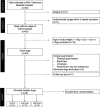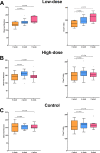Red Ginseng Dietary Fiber Shows Prebiotic Potential by Modulating Gut Microbiota in Dogs
- PMID: 37367492
- PMCID: PMC10433987
- DOI: 10.1128/spectrum.00949-23
Red Ginseng Dietary Fiber Shows Prebiotic Potential by Modulating Gut Microbiota in Dogs
Abstract
Red ginseng, widely used in traditional medicine for various conditions, imparts health benefits mainly by modulating the gut microbiota in humans. Given the similarities in gut microbiota between humans and dogs, red ginseng-derived dietary fiber may have prebiotic potential in dogs; however, its effects on the gut microbiota in dogs remain elusive. This double-blinded, longitudinal study investigated the impact of red ginseng dietary fiber on the gut microbiota and host response in dogs. A total of 40 healthy household dogs were randomly assigned to low-dose (n = 12), high-dose (n = 16), or control (n = 12) groups and fed a normal diet supplemented with red ginseng dietary fiber (3 g/5 kg body weight per day, 8 g/5 kg per day, or no supplement, respectively) for 8 weeks. The gut microbiota of the dogs was analyzed at 4 weeks and 8 weeks using 16S rRNA gene sequencing of fecal samples. Alpha diversity was significantly increased at 8 and 4 weeks in the low-dose and high-dose groups, respectively. Moreover, biomarker analysis showed that short-chain fatty acid producers such as Sarcina and Proteiniclasticum were significantly enriched, while potential pathogens such as Helicobacter were significantly decreased, indicating the increased gut health and pathogen resistance by red ginseng dietary fiber. Microbial network analysis showed that the complexity of microbial interactions was increased by both doses, indicating the increased stability of the gut microbiota. These findings suggest that red ginseng-derived dietary fiber could be used as a prebiotic to modulate gut microbiota and improve gut health in dogs. IMPORTANCE The canine gut microbiota is an attractive model for translational studies, as it responds to dietary interventions similarly to those in humans. Investigating the gut microbiota of household dogs that share the environment with humans can produce highly generalizable and reproducible results owing to their representativeness of the general canine population. This double-blind and longitudinal study investigated the impact of dietary fiber derived from red ginseng on the gut microbiota of household dogs. Red ginseng dietary fiber altered the canine gut microbiota by increasing diversity, enriching short-chain fatty acid-producing microbes, decreasing potential pathogens, and increasing the complexity of microbial interactions. These findings indicate that red ginseng-derived dietary fiber may promote canine gut health by modulating gut microbiota, suggesting the possibility of its use as a potential prebiotic.
Keywords: dietary fiber; dog; gut microbiota; nanopore sequencing; red ginseng.
Conflict of interest statement
The authors declare no conflict of interest.
Figures





Similar articles
-
Modulation of Gut Microbiota by Red Ginseng Extract Powder and Dietary Fiber in Obese Mice: Identification of Key Microbial Candidates.J Microbiol Biotechnol. 2025 Aug 18;35:e2506016. doi: 10.4014/jmb.2506.06016. J Microbiol Biotechnol. 2025. PMID: 40825667 Free PMC article.
-
Habitual dietary fibre intake influences gut microbiota response to an inulin-type fructan prebiotic: a randomised, double-blind, placebo-controlled, cross-over, human intervention study.Br J Nutr. 2018 Jan;119(2):176-189. doi: 10.1017/S0007114517003440. Epub 2018 Jan 8. Br J Nutr. 2018. PMID: 29307330 Clinical Trial.
-
Prebiotic effects of diet supplemented with the cultivated red seaweed Chondrus crispus or with fructo-oligo-saccharide on host immunity, colonic microbiota and gut microbial metabolites.BMC Complement Altern Med. 2015 Aug 14;15:279. doi: 10.1186/s12906-015-0802-5. BMC Complement Altern Med. 2015. PMID: 26271359 Free PMC article.
-
Effect of fructans, prebiotics and fibres on the human gut microbiome assessed by 16S rRNA-based approaches: a review.Benef Microbes. 2020 Mar 27;11(2):101-129. doi: 10.3920/BM2019.0082. Epub 2020 Feb 19. Benef Microbes. 2020. PMID: 32073295 Review.
-
Designing future prebiotic fiber to target metabolic syndrome.Nutrition. 2014 May;30(5):497-502. doi: 10.1016/j.nut.2013.08.013. Epub 2013 Oct 2. Nutrition. 2014. PMID: 24262515 Review.
Cited by
-
Microbiota of healthy dogs demonstrate a significant decrease in richness and changes in specific bacterial groups in response to supplementation with resistant starch, but not psyllium or methylcellulose, in a randomized cross-over trial.Access Microbiol. 2024 May 14;6(5):000774.v4. doi: 10.1099/acmi.0.000774.v4. eCollection 2024. Access Microbiol. 2024. PMID: 38868374 Free PMC article.
-
Probiotics ameliorate atopic dermatitis by modulating the dysbiosis of the gut microbiota in dogs.BMC Microbiol. 2025 Apr 22;25(1):228. doi: 10.1186/s12866-025-03924-6. BMC Microbiol. 2025. PMID: 40264044 Free PMC article.
-
Effects of red ginseng extract and red ginseng dietary fiber on the maintenance of intestinal immune and functional homeostasis in diet-induced obese mice.J Ginseng Res. 2025 May;49(3):271-281. doi: 10.1016/j.jgr.2025.01.006. Epub 2025 Jan 30. J Ginseng Res. 2025. PMID: 40453347 Free PMC article.
-
The Role of Plant Extracts in Enhancing Nutrition and Health for Dogs and Cats: Safety, Benefits, and Applications.Vet Sci. 2024 Sep 12;11(9):426. doi: 10.3390/vetsci11090426. Vet Sci. 2024. PMID: 39330805 Free PMC article. Review.
-
Beneficial effects of American ginseng (Panax quinquefolius L.) extract residue as a feed additive on production, health status, and gastrointestinal bacteria in sika deer (Cervus nippon).Front Microbiol. 2024 Mar 13;15:1344905. doi: 10.3389/fmicb.2024.1344905. eCollection 2024. Front Microbiol. 2024. PMID: 38544859 Free PMC article.
References
Publication types
MeSH terms
Substances
LinkOut - more resources
Full Text Sources

